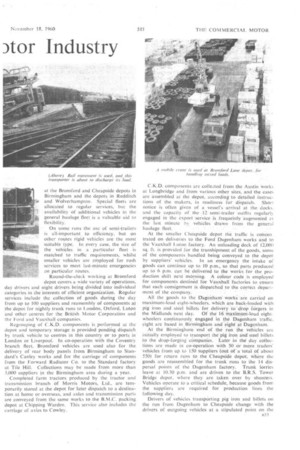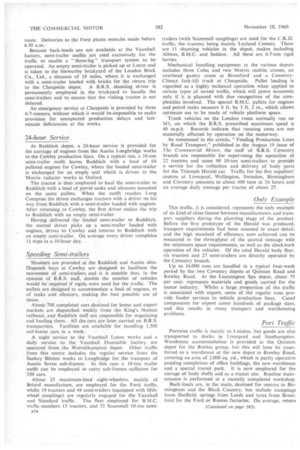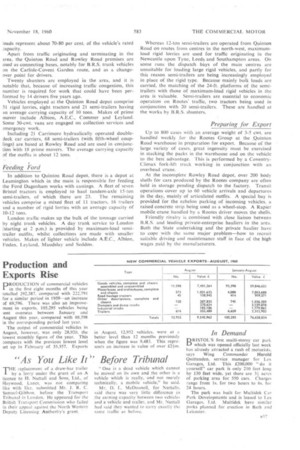B.R.S. for ti
Page 66

Page 67

Page 68

Page 71

If you've noticed an error in this article please click here to report it so we can fix it.
)tor Industry
Midlands Network is Aimed to Integrate Vehicle Production
By P. A. C. Brockington,
A.M.I.Mech.E.
S . ENIOR staff of British Road Services' Birmingha District claim that close liaison with leading vehic manufacturers has benefited transport efficiency at expansion of the industry in a way that is unmatched 1 any other transport project. This particularly applies the major producers in the area, the British Motor Co poration, with whom joint planning has been an essenti feature of co-operative action over the years.
The layout of dispatch bays, the design of pallets ai the provision of suitable cases for C.K.D. parts are a ft of the many aspects of transport organization that ha been the subjects of joint consultation, to the mutu benefit to the vehicle manufacturer and the operator. ( the more routine side, detailed problems relating schedules. delivery times and so on are constantly und review to ensure that deliveries are strictly co-ordinat, with production requirements, and empty running reduced to the minimum. Operation of various producti lines of B.M.C., Ford, Vauxhall and Standard depends 4 the arrival of parts at a stipulated time, with a latitu, measured in minutes rather than hours.
Road transport for the motor industry represents mo than 25 per cent, of the total of traffic at the 10 B.R. depots in the district and is mainly covered by operatio
at the Bromford and Cheapside depots in Birmingham and the depots in Redditch and Wolverhampton. Special fleets are allocated to regular services, but the availability of additional vehicles in the general haulage. fleet is a vahtable aid to flexibility.
On some runs.-the use of semi-trailers is all-importaht to efficiency, but on other routes rigid vehicles are the most suitable type. In every case, the size of the vehicles in a particular fleet is matched to traffic requirements, whilst smaller vehicles are employed for rush services to meet last-minute emergencies on particular routes.
Round-the-clock working at Bromford depot covers a wide variety of operations, day drivers and night drivers being divided into individual categories in the interests of efficient organithtion. Regular services include the collection of goods during the day from up to 100 suppliers and reassembly of components .at the depot for nightly trunk runs to London, Oxford, Lut.ori and other centres for the British Motor Corporation and the Ford and Vauxhall companies.
Regrouping of C.K.D. components is performed at the depot and temporary storage is provided pending dispatch by trunk vehicle to centres in this country or to ports in London or Liverpool. In co-operation with the Coventry branch fleet, Bromford vehicles are used also for the delivery of rear body panels from Birmingham to Standard's Canley works and for the carriage of components from the Forward Radiator Co. to the Standard factory at Tile Hill. Collections may be made from more than 3,000 suppliers in the Birmingham area during a year.
Completed farm tractors produced by the tractor and transmission branch of Morris Motors, Ltd., are temporarily stored at the depot for later dispatch to a destination at home or overseas, and axles and transmission parts are conveyed from the same works to the B.M.C. packing depot at Chipping Warden. This service also includes the carriage of axles to Cowley.
C.K.D. components are collected from the Austin Works at Longbridge and from various other sites, and the cases are assembled at the depot, according to detailed instructions of the makers, in readiness for dispatch. Short notice is often given of a vessel's •arrival at the: docks. and the capacity of the 12 semi-trailer :outfit's regidarl■ engaged in the export service is freqUently:auginented vt the last Minute by vehicles drawnfrom the general haulage fleet.
At the smaller CheapSide dePot• the traffic is concen trated on deliveries tO the Ford Dagenham works and to the Vauxhall Luton factory. An Unloading deck of 12,000 sq. ft. is provided for the transhipment of the goods, some of the components handled being conveyed to the depot by suppliers' vehicles. In an emergency the intake of goods can continue up to I0 p.m., so that parts produced up to 6 p.m. can be delivered to the works: for the production shift next: morning. N Colour code is employed for components destined for Vauxhall factories to ensure that each consignment is diSpatehed to the airrect clepari
ment of the company: •
All the goods to the Dagenhani Works are carried on maximum-load eight-wheelers, which are .back-loaded ..with Pig iron and Steel billets for 'delivery to-drop fOrgers in the Midlands. next day: Of the 16 maximum load eight wheelers continuously engaged in the Dagenham traffic. eight are based in Birmingham and eight at -Dagenham.
At the Birmitighaim'end of the run the Vehicles are initially employed to transport the pig iron and steel billets to the drop-forging-c6nripanies. Later in the day collections are made in co-Operation with 50 '-dr more traders' vehicles from up to 150 suppliers .(Out a'total of about 550) for return runs to the Cheapside depot; Where the goods are reassembled for the trunk runs to the 14 dispersal points of the Dagenham factory. Trunk lorries leave at 10.30 p.m. and are driven to the B.R.S. Tower Bridge depot, where they are taken over by shunters. Vehicles operate to a critical schedule, because goods from the suppliers are required for production lines the following day.
Drivers of vehicles transporting pig iron and billets on the run from Dagenham to Cheapside change with the drivers of outgoing vehicles at a stipulated point on the n33 route. Deliveries to the Ford plants must.be made before 6.30 a.m.
Because back-loads are not available at the Vauxhall factory, semi-trailer outfits are used exclusively for the traffic to enable a " three-leg " transport system to be operated. An empty semi-trailer is picked up at Luton and is taken to the Stewartby brickyard of the London Brick Co., Ltd., a distance of 18 miles, where it is exchanged with a semi-trailer loaded with bricks for the return trip to the Cheapside depot. A B.R.S. shunting driver is permanently employed in the brickyard to handle the semi-trailers and to ensure that the visiting tractor is not delayed.
An emergency service at Cheapside is provided by three 6-7-tormers, without which it would be-impossible to make provision for unexpected production delays and lastminute deficiencies at the works.
24-hour Service
At Redditch depot, a 24-hour service is provided for the carriage of engines from the Austin Longbridge works to the Cowley production lines. On a typical run, a 10-ton semi-trailer outfit leaves Redditch with a load of 64 palleted engines for Cowley, where the loaded semi-trailer is exchanged for an empty unit which is driven to the Morris radiator works in Oxford.
The tractor is then employed to haul the semi-trailer to Redditch with a load of petrol tanks and silencers mounted on the same pallets. When the outfit reaches Long Compton the driver exchanges tractors with a driver on his way from Redditch with a semi-trailer loaded with engines. After returning to Cowley, the first driver makes the trip to Redditch with an empty semi-trailer.
Having delivered the loaded semi-trailer to Redditch, the second driver picks up a semi-trailer loaded with engines, drives to Cowley and returns to Redditch with an empty semi-trailer. On average every driver completes 14 trips in a 10-hour day.
Speeding Semi-trailers
Shunters are provided at the Redditch and Austin sites. Dispatch bays at Cowley are designed to facilitate the movement of semi-trailers and it is notable that, in the opinion of B.R.S. staff, double the number of vehicles would be required if rigids were used for the traffic. The pallets are designed to accommodate a load of engines, or of tanks and silencers, making the best possible use of space.
About 700 completed cars destined for home and export markets are dispatched weekly from the King's Norton railhead, and Redditch staff are responsible for organizing and loading them. All the cars are later carried on B.R.S. transporters. Facilities are available for handling 1,500 rail-borne cars in a week.
A night service to the .Vauxhall Luton works and a daily service to the Vauxhall Dunstable factory are operated from the Wolverhampton depot. Other traffic from this centre includes the regular service from the Sankey Bilston works to Longbridge for the transport of Austin Seven sub-frames. In this case a 10-ton trailer outfit can be employed to carry sub-frames sufficient for 350 cars.
About 25 maximum-load eight-wheelers, mainly of Bristol manufacture, are employed for the Ford traffic, whilst 19 tractors and 44 semi-trailers (equipped with fifthwheel couplings) are regularly engaged for the Vauxhall and Standard traffic. The fleet employed for B.M.C. traffic numbers 13 tractors, and 33 Scammell 10-ton semi B34 trailers (with Scammell couplings) are used for the C.K.D. traffic, the tractors being mainly Leyland Comets. There are 11 shunting vehicles in the depot, makes including Albion, B.M.C. and Seddon. All these are 6-7-ton rigid lorries.
Mechanical handling equipment at the various depots includes three Coles and two Morris mobile cranes, an overhead gantry crane at Bromford and a CoventryClimax fork-lift truck at Cheapside. Pallet loading is regarded as a highly technical operation when applied to certain types of mixed traffic, which will prove economic only if it is planned with due recognition of the complexities involved. The special B.M.C. pallets for engines and petrol tanks measure 6 ft. by 3 ft. 2 in., which allows optimum use to be made of vehicle platform space.
Trunk vehicles on the London route normally run on MI, on which the B.R.S. prescribed maximum speed is 40 m.p.h. Records indicate that running costs are not materially affected by operation on the motorway.
As mentioned in the article, "Feeding Production Lines by Road Transport," published in the August 19 issue of The Commercial Motor, the staff of R.R.S. Coventry branch are responsible for supervising the operation of 22 tractors and some 90 10-ton -semi-trailers to provide a service for the collection and delivery of body parts for the Triumph Herald car. Traffic for the five suppliers' centres at Liverpool, Wellington, Swindon, Birmingham and Coventry amounts to about 600 tons in 24 hours and an average daily tonnage per tractor of about 27.
Only Example
This traffic, it is considered, represents the only example of its kind of close liaison between manufacturers and transport suppliers during the planning stage of the product. Before the first prototype of the Herald was produced, transport requirements had been assessed in exact-detail, and the high standard of efficiency now achieved can be measured in the throughput of the quoted tonnage with the minimum space requirements, as well as the clockwork operation of the vehicles. Of the total Herald body fleet, six tractors and 27 semi-trailers are directly operated by the Coventry branch.
Up to 16,000 tons are handled in a typical four-week period by the two Coventry depots at Quinton Road,and Rowley Road, At the Leamington Spa depot, about 75 per cent. represents materials and goods carried for the motor industry. Whilst a large proportion of the traffic is associated with export, some of the regular runs provide feeder services to vehicle production lines. ' Cased components for export cover hundreds of package sizes, and this results in many transport and warehousing problems.
Port Traffic
Portwise traffic is mainly to London, but goods are also transported to docks in Liverpool and Southampton. Warehouse accommodation is provided at the Quinton depot for the Rootes group, but this will later be transferred to a warehouse at the new depot in Rowley Road, covering an area of 2,000 sq. yd., which is partly operative pending completion of office buildings, the new warehouse and a special transit park. It is now employed for the storage of body shells and as a transit site Routine maintenance is performed at a recently completed workshop.
Back-loads are, in the main, destined for centres in Birmingham and the Black Country, but include stampings from Sheffield, springs from Leeds and tyres from Brentford for the .Ford or Rootes factories. On average, return Loads represent about 70-80 per cent. of the vehicle's rated :apacity.
Apart from traffic originating and terminating in the area, the Quinton Road and Rowley Road premises are Lised as connecting bases, notably for B.R.S. trunk vehicles an the Carlisle-Covent Garden route, and as a changeDyer point for drivers.
Twenty shunters are employed in the area, and it is notable that, because of increasing traffic congestion, this number is required for work that could have been performed by 14 drivers five years ago.
Vehicles employed at the Quinton Road depot comprise 31 rigid lorries, eight tractors and 21 semi-trailers having art average carrying capacity of 10 tons. Makes of prime [nosier include Albion, A.E.C., Commer, and Leyland. some 30-cwt. vans are engaged on collection services and 2rnergency work.
Including 21 Carrimore hydraulically operated doubledeck car carriers. 68 semi-trailers (with fifth-wheel couplings) are based at Rowley Road and are used in conjunction 'With 18 prime movers. The average carrying capacity at the outfits is about 12 tons.
Feeding Ford
In addition to Quinton Road depot, there is a depot at Leamington which in the main is responsible for feedirrg the Ford Dagenham works with castings. A fleet of seven Bristol tractors is employed to haul tandem-axle 15-ton semi-trailers, of which there are 23. The remaining vehicles comprise a mixed fleet of 11 tractors, 16 trailers and a number of rigid lorries with an average capacity of 10-12 tons.
London traffic makes up the bulk of the tonnage carried by night trunk vehicles. A day trunk service to London starting at 2 p.m.) is provided by maximum-load semitrailer outfits, whilst collections are made with smaller vehicles. Makes of lighter vehicle include A.E.C., Foden, Leyland, Maudstay and Seddon.
Whereas 12-ton semi-trailers are operated from Quinton Road On routes from centres in the north-west, maximumload rigid lorries are used for traffic originating in the Newcastle upon Tyne, Leeds and Southampton areas. On some runs the dispatch bays of the main centres are unsuitable for loading large rigid vehicles, and partly for this reason semi-trailers are being increasingly employed in place of the rigid type. Because mainly bulk loads are carried, the matching of the 24-ft. platforms of the semitrailers with those of maximum-lOad rigid vehicles in the area is valuable. Semi-trailers are essential to economic operation on Rootes. traffic, two tractors being used in conjunction with 20 semi-trailers. These are handled at the works by B.R.S. shunters.
Preparing for Export
Up to 800 cases with an average weight of 3-5 cwt. are handled weekly for the Rootes Group at the Quinton Road warehouse in preparation for export. Because of the large variety of cases, great ingenuity must be exercised in stacking the packs in the warehouse and on the vehicle to the best advantage. This is performed by a CoventryClimax fork-lift truck working in conjunction with an overhead crane.
At the incomplete Rowley Road depot, over 200 body shells for cars produced by the Rootes company are often held in storage pending dispatch to the factory. Transit operations cover up to 60 vehicle arrivals and departures in the day, mainly of articulated outfits. A special bay is provided for the echelon parking of incoming vehicles, a raised concrete strip being used as a wheel-stop. A Rapier mobile crane handled by a Rootes driver moves the shells.
Friendly rivalry is combined with close liaison between B.R.S. and leading private-enterprise hauliers in the area. Both the State undertaking and the private haulier have to cope with the same major problem—how to recruit suitable driving and maintenance staff in face of the high wages paid by the manufacturers.




































































































































